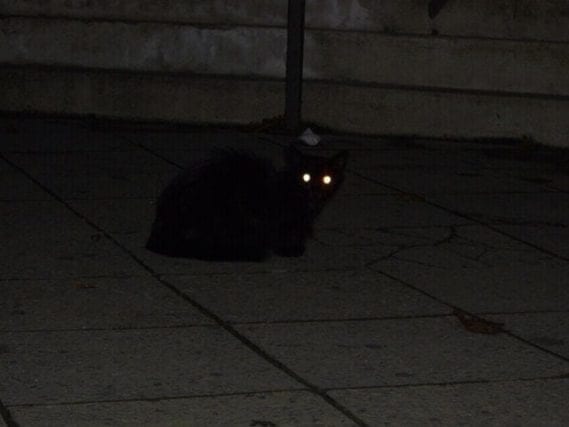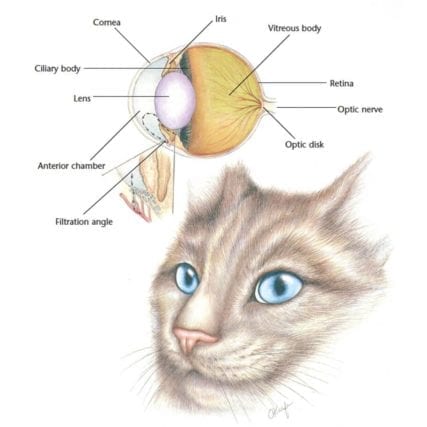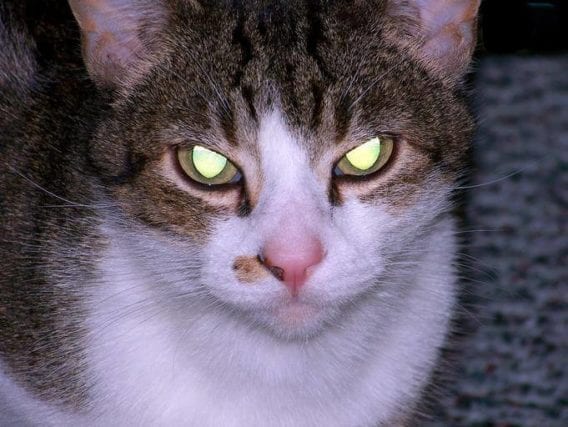The eyes of many predators in the animal kingdom light up in the dark and the cat is no exception. In fact, our feline friends inherited this ability from their considerably larger ancestors.
Seeing the eyes of a cat in the middle of the night can suddenly be frightening and that is why this characteristic of our four-legged friends has given rise to numerous legends since the time of the ancient Egyptians. In this shelterapet article, we will explain why cats’ eyes glow in the dark.
How does a cat’s eye work?
If you compare the human and cat’s eyes, then you can find a number of differences. It is they who determine the peculiarities of their vision. We do not want to confuse you with abstruse biological terms, so we will try to tell you about how the cat’s eye works, simply and clearly.
The figure shows a schematic structure of a cat’s eye. Each element serves a specific purpose. Their functions and characteristics determine the peculiarity of feline vision.
Sclera. The outer shell maintains the correct shape of the eye.
Cornea (stratum corneum). Performs protective functions. It has a convex shape and protects the delicate iris and pupil from external damage.
Vascular layer. Without it, the functioning and nutrition of the eyes would be impossible. Yes, they also need nutrients and oxygen.
Lens. Many people think of this organ as a cut diamond. But in reality, it is a liquid substance. However, its functions are very similar to a real diamond. It also refracts and transforms the incoming stream of light.
Retina. Due to the presence of photoreceptors, this organ is responsible for the perception of the entire light flux that has passed through the cornea and lens. The first and very important feature of a cat’s vision lies precisely in this. The fact is that both in us and in our smaller brothers, photoreceptors are represented by cones and rods. Their ratio determines the acuity and receptivity of the eyes. So, in cats, the vast majority are precisely rods (there are 25 times more of them than cones).
Tapetum. This is a special reflective layer that nature has endowed felines with. Thanks to It, they have such keen eyesight and see well in the dark. Everything is simple here. In humans, only the retina catches the streams of light, but not all of them fall on it. In a cat, even the rays that have passed the retina will be captured and reflected by this layer. This means that the brain will receive more information from the optic nerves.
The optic nerve. The information received by the retina and reflected from the tapetum is converted into electrical impulses that go directly to the brain and are processed there.
We did not list all the organs that make up the cat’s eye. The fact is that it’s these main parts that are directly related to our topic. Already on the basis of this information, it becomes clear that cats’ vision is unique, although in many respects similar to ours.

Features of The Cats Vision
So, we’veve examined the components of a cat’s eye. Now it remains to draw conclusions and learn about the features.
Even with the naked eye, it is clear that the organs of vision of our pets are set quite deeply. Therefore, it is more difficult for them to see objects located on the periphery. The same feature explains the limited mobility of the eye itself.
The pupil is vertical. Its size depends entirely on the lighting. The stronger the light, the narrower gets. In daylight, it completely turns into a narrow crack. The fact is that this amount of light rays (which pass through it) will be enough to give complete information to the brain about the environment.
Direct exposure to sunlight is detrimental to the eyes. It’s all about their increased sensitivity. On average, it’s 7 times more sensitive than human eyes.
Each eye has its own visual field. That is, the area around, from which he reads information (receives a stream of light). The left and right eye fields overlap. This explains the fact that cats see 3D images.
Our pets have color vision, although it is different from ours. They perfectly distinguish the shades of the upper spectrum (blue, green). But all shades of red they see in gray. The same applies to colors such as orange and yellow.
If it is easier for us to see any object in statics, then in born hunters the emphasis is shifted to moving objects. This feature becomes critical in the wild. That is why the cat will notice even the slightest movement or movement in the apartment.

So Why Do Cat eyes Glow
At night, leaving the room and accidentally bumping into your pet, you can see how Its eyes are burning with bright lights. But contrary to this common expression, their eyes do not shine. But how is that?
The thing is that a special layer, the tapetum, which we talked about earlier, is a mirror surface. Even the slightest stream of light that hits it is reflected. And we see exactly this reflected light.
Contrary to popular belief, even a cat with its unique vision cannot see in pitch darkness. In order for the brain to receive information, at least a weak light source is needed. Many will argue that they saw how the eyes of these animals flare-up in the dark.
The fact is that those weak light sources that are in this darkness are not perceived by the human eye. It seems to us that the room is completely dark, but this amount is enough for a cat family.
Why do the colors differ?
Many may have noticed that in different breeds of cats, the retina of the eye has a different color. This is indeed the case. But this is not at all the main reason for the different glow.
It’s all about the mirror layer on the back of the eye again. With the same structure, this organ can have a different chemical composition and pigmentation. Due to this, shades from yellow to purple are obtained. More often see green and yellow reflections.
The different colors are also explained by the structure of this layer. In some, it covers the entire back wall, while others have pigmented areas. And also the colors are refracted due to the interlayer, it is she who gives the green glow.
If you think that only our pets have such a unique feature, you are mistaken. Take a look at your photos. Is there an effect called “red eyes” on them? This is also nothing more than the reflection of light rays. And the red light is explained by the presence of vascular compounds, which color the flow in this shade.
Suitable for hunting
” This concerns dogs, cats, cattle, deer, horses, and ferrets,” Dr. Bill Miller, a veterinary ophthalmologist at the Memphis Animal Ophthalmology Clinic in Tennessee, told Vetstreet. United).
” However, humans and primates don’t have this ‘tapetum lucidum’, nor do squirrels because they are more active during the day, so their retinas are designed for brighter light vision,” he said. This famous reflective membrane would be particularly suitable for animals inclined to hunting.
According to Dr. Cynthia Powell, a veterinary ophthalmologist at Colorado State University, this anatomical characteristic would have been naturally transmitted, over the course of evolution, to domestic cats by their ancestors.


